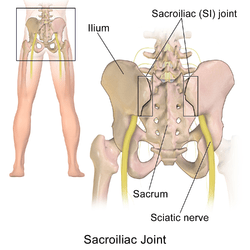Sacroiliac Joint Pain
A Common Cause of Low Back Pain. And it’s not your Back!
In many cases of back pain we see and treat the cause is not the back or spine at all but instead is from a joint or joints in the pelvis-the Sacro-Iliac Joint (SIJ).
Patients have often suffered prolonged pain and may have been incorrectly diagnosed along the way with sciatica, a disc problem or told it is muscle spasm. They are then given the wrong advice regarding exercises etc. which often aggravates the problem further.
Symptoms may start gradually with no known cause or there be a sudden onset associated with pregnancy, a poor sitting position or a fall-especially if there has been a sudden force through the hip or bottom.
All these are common causes of SIJ problems.

Sacro-iliac joint
The Sacro- iliac joints are located between the sacrum, the wedge-shaped bone at the base of the spine and the two pelvic bones (ilium).
One of the joints may become disrupted or strained causing inflammation and subsequent pain. Muscles around the joint may spasm, become weak or develop painful knots or trigger points.The joint surfaces are rough and interlock together for stability but they can move. This is especially the case in late stage pregnancy when hormones helps ‘soften’ the ligaments to allow the baby to pass through the pelvis more easily.
As the pelvis it is the centre of the body and all forces through the leg and hip come through to the spine through the SIJ even slight changes can cause severe pain and weakness in the low back, groin and hip and even refer as far as the foot or shoulder.
Diagnosis with x-ray or even MRI can be difficult as unless there is severe degeneration or fusing of the joint it usually appears normal.
Sacroiliac Joint Dysfunction Animation – Everything You Need To Know – Dr. Nabil Ebraheim, M.D.
About SIJ dysfunction
Common symptoms of SIJ dysfunction
Patients usually complain of pain on one side around the very base of the back and into the buttock or side.
Aggravated by:
- Turning over in bed
- Moving from sitting to standing
- Getting in and out of a car
- Walking or stairs
- Lying supine (on the back) with legs out straight.
Possible causes of SIJ dysfunction
This may be a sudden force or trauma or overuse with repetitive movements or positions.
- Collison when driving with the foot on the pedal
- Twisting and lifting
- Pregnancy
- Excessive stress post pregnancy (car seats, bathing baby, lifting and carrying)
- Long term issues in knees, hips or ankle. (Producing one sided weakness0
- Landing heavily on one leg.
- Prolonged sitting-especially with twisting
Physiotherapy Assessment of low back/pelvic pain
Our physiotherapists initially take a comprehensive history of the problem, the symptoms, aggravating factors etc. which is often sufficient information for us to suspect an SIJ problem.
We then conduct specialised tests to screen the spine, pelvis, hips and sacro- iliac joint to produce an accurate diagnosis and treatment plan.
Treatment of Sacro- iliac Joint dysfunction
In severe cases, especially in pregnancy when instability is an issue a belt or support may be necessary to compress and stabilize the pelvis.
Physiotherapy uses many techniques and treatments to regain the correct balance of joints and muscles in the pelvis including exercises, mobilisation and taping.
Regaining the strength and stability of the core supporting muscles is essential and Pilates type exercises are excellent at focusing on these-whether in a class or one to one with the physiotherapist.
So if you suspect your back pain is caused by your sacro- iliac joint but have had no diagnosis or effective treatment then make an appointment with one of our experienced physiotherapists at Physio Answers and get the problem sorted-now! Call us on 0203 538 3808
